Intel Core i9-10850K Review: The Real Intel Flagship
by Dr. Ian Cutress on January 4, 2021 9:00 AM EST- Posted in
- CPUs
- Intel
- Core
- Z490
- 10th Gen Core
- Comet Lake
- LGA1200
- i9-10850K
CPU Tests: Simulation
Simulation and Science have a lot of overlap in the benchmarking world, however for this distinction we’re separating into two segments mostly based on the utility of the resulting data. The benchmarks that fall under Science have a distinct use for the data they output – in our Simulation section, these act more like synthetics but at some level are still trying to simulate a given environment.
DigiCortex v1.35: link
DigiCortex is a pet project for the visualization of neuron and synapse activity in the brain. The software comes with a variety of benchmark modes, and we take the small benchmark which runs a 32k neuron/1.8B synapse simulation, similar to a small slug.
The results on the output are given as a fraction of whether the system can simulate in real-time, so anything above a value of one is suitable for real-time work. The benchmark offers a 'no firing synapse' mode, which in essence detects DRAM and bus speed, however we take the firing mode which adds CPU work with every firing.
The software originally shipped with a benchmark that recorded the first few cycles and output a result. So while fast multi-threaded processors this made the benchmark last less than a few seconds, slow dual-core processors could be running for almost an hour. There is also the issue of DigiCortex starting with a base neuron/synapse map in ‘off mode’, giving a high result in the first few cycles as none of the nodes are currently active. We found that the performance settles down into a steady state after a while (when the model is actively in use), so we asked the author to allow for a ‘warm-up’ phase and for the benchmark to be the average over a second sample time.
For our test, we give the benchmark 20000 cycles to warm up and then take the data over the next 10000 cycles seconds for the test – on a modern processor this takes 30 seconds and 150 seconds respectively. This is then repeated a minimum of 10 times, with the first three results rejected. Results are shown as a multiple of real-time calculation.
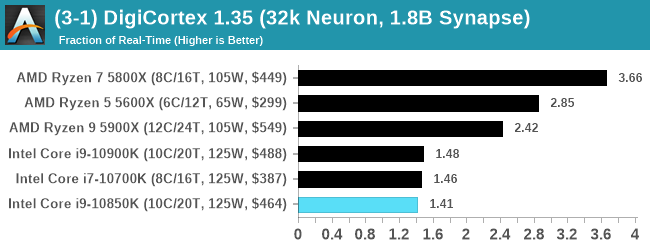
The wide variation on AMD seems to prefer high-core-count single chiplet processors. Intel is taking a back seat here, as it is also using slower memory.
Dwarf Fortress 0.44.12: Link
Another long standing request for our benchmark suite has been Dwarf Fortress, a popular management/roguelike indie video game, first launched in 2006 and still being regularly updated today, aiming for a Steam launch sometime in the future.
Emulating the ASCII interfaces of old, this title is a rather complex beast, which can generate environments subject to millennia of rule, famous faces, peasants, and key historical figures and events. The further you get into the game, depending on the size of the world, the slower it becomes as it has to simulate more famous people, more world events, and the natural way that humanoid creatures take over an environment. Like some kind of virus.
For our test we’re using DFMark. DFMark is a benchmark built by vorsgren on the Bay12Forums that gives two different modes built on DFHack: world generation and embark. These tests can be configured, but range anywhere from 3 minutes to several hours. After analyzing the test, we ended up going for three different world generation sizes:
- Small, a 65x65 world with 250 years, 10 civilizations and 4 megabeasts
- Medium, a 127x127 world with 550 years, 10 civilizations and 4 megabeasts
- Large, a 257x257 world with 550 years, 40 civilizations and 10 megabeasts
DFMark outputs the time to run any given test, so this is what we use for the output. We loop the small test for as many times possible in 10 minutes, the medium test for as many times in 30 minutes, and the large test for as many times in an hour.
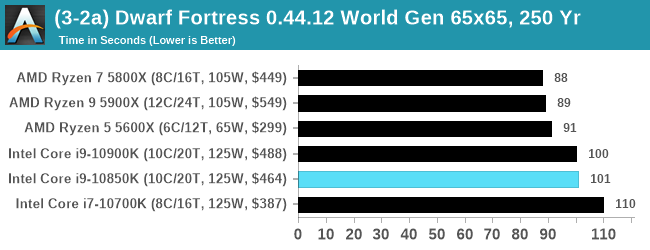
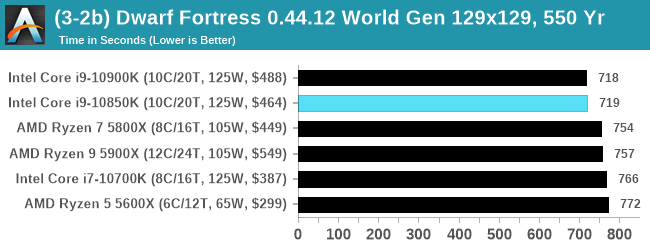
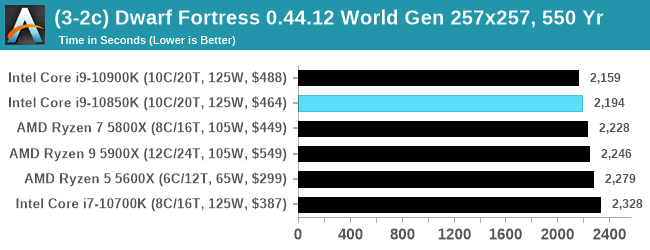
Dolphin v5.0 Emulation: Link
Many emulators are often bound by single thread CPU performance, and general reports tended to suggest that Haswell provided a significant boost to emulator performance. This benchmark runs a Wii program that ray traces a complex 3D scene inside the Dolphin Wii emulator. Performance on this benchmark is a good proxy of the speed of Dolphin CPU emulation, which is an intensive single core task using most aspects of a CPU. Results are given in seconds, where the Wii itself scores 1051 seconds.
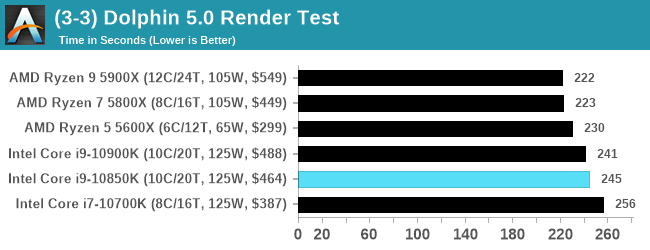












126 Comments
View All Comments
Kevin G - Monday, January 4, 2021 - link
Inconsistency error on the second page: the 10850K and 10900K swap colors in the graphs.With regards to the intercore latency, what is the internal bus topology like in the 10 core Comet Lake? Last I heard, Intel was still using the ring topology for client processors but did they finally add a second ring similar to what they did for the medium and high core core count Xeons pre-Sky Lake? That'd explain why two of the cores seem off from the rest (and I would presume the GPU and PCIe controller would also sit on that same ring).
Spunjji - Monday, January 4, 2021 - link
I genuinely appreciate the detail put into this article, but it's amusing that it was prompted by what amounts to little more than a bait-and-switch on their top-end product. 😬 The way I'm looking at it, they either used the early reviews to lie about the price of their *theoretical* flagship CPU, or they used the early reviews to lie about the power characteristics of their *actually available* flagship CPU.Either way, the end result remains the same: never trust Intel PR, and avoid their products unless you like to use your PC as a small household water heater.
JessNarmo - Monday, January 4, 2021 - link
All companies lie and do questionable stuff, all that matters is what you getting for the money.And in winter small house heater in much appreciated when running script overnight allows you to avoid using house air heater in the room ;D
I think 10850k could be a pretty good deal if $400 or cheaper and you can't wait for AMD availability.
But I think it's only viable option for those who still rocking DDR3 or those who have no PC at all for the rest of us waiting is better. CPU upgrade is just not worth it as long as you have anything Skylake based on zen2 based.
Qasar - Tuesday, January 5, 2021 - link
" All companies lie and do questionable stuff " not compared to intel, they have been pretty much lieing for how many years now about how its 10nm tech is coming along.GeoffreyA - Wednesday, January 6, 2021 - link
Maybe Intel should go into the geyser business ;)zamroni - Monday, January 4, 2021 - link
Intel should remove the low spec on die integrated gpu and replace it with more powerful gpu chiplet.JessNarmo - Monday, January 4, 2021 - link
Intel should remove integrated GPU from all high end CPU's. It's completely pointless. No one is using $500 CPU and using integrated graphics. Silicone is better spent on better CPU.heftig - Monday, January 4, 2021 - link
I am, actually. For a soho+media server and distcc host which only needs a GPU for whatever can't be done over SSH.temps - Monday, January 4, 2021 - link
good to see anandtech still has the biggest gap between quality of articles and quality of comment sectionrunning a 9900K with integrated here, the computer is for audio production and has no use for a graphics card. intel outperforms ryzen for this workload too.
powerarmour - Tuesday, January 5, 2021 - link
Sorry to disappoint if you've been hiding under a rock for a couple of years, but this is no longer the case, check any recent Scan dawbench articles...